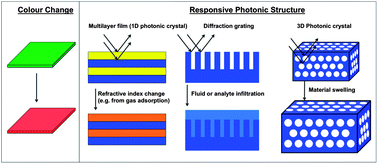Structural colour in colourimetric sensors and indicators
Abstract
Colourimetric sensors and

- This article is part of the themed collection: The Chemistry of Photonic Crystals and Metamaterials
* Corresponding authors
a
Wyss Institute for Biologically Inspired Engineering, Harvard University, Cambridge, MA, USA
E-mail:
ibburges@fas.harvard.edu
b
School of Engineering and Applied Sciences, Harvard University, Cambridge, MA, USA
E-mail:
loncar@seas.harvard.edu, jaiz@seas.harvard.edu
c Department of Chemistry and Chemical Biology, Harvard University, Cambridge, MA, USA
d Kavli Institute for Bionano Science & Technology, Harvard University, Cambridge, MA, USA
Colourimetric sensors and

 Please wait while we load your content...
Something went wrong. Try again?
Please wait while we load your content...
Something went wrong. Try again?
I. B. Burgess, M. Lončar and J. Aizenberg, J. Mater. Chem. C, 2013, 1, 6075 DOI: 10.1039/C3TC30919C
To request permission to reproduce material from this article, please go to the Copyright Clearance Center request page.
If you are an author contributing to an RSC publication, you do not need to request permission provided correct acknowledgement is given.
If you are the author of this article, you do not need to request permission to reproduce figures and diagrams provided correct acknowledgement is given. If you want to reproduce the whole article in a third-party publication (excluding your thesis/dissertation for which permission is not required) please go to the Copyright Clearance Center request page.
Read more about how to correctly acknowledge RSC content.
 Fetching data from CrossRef.
Fetching data from CrossRef.
This may take some time to load.
Loading related content
